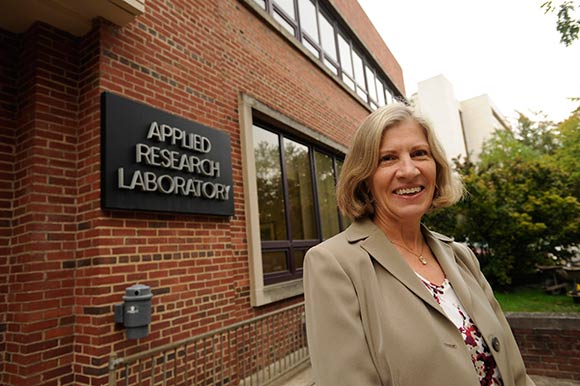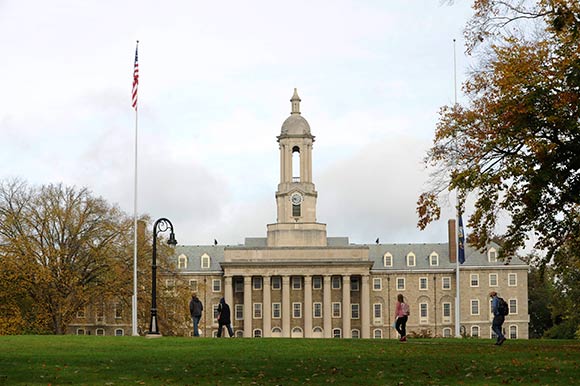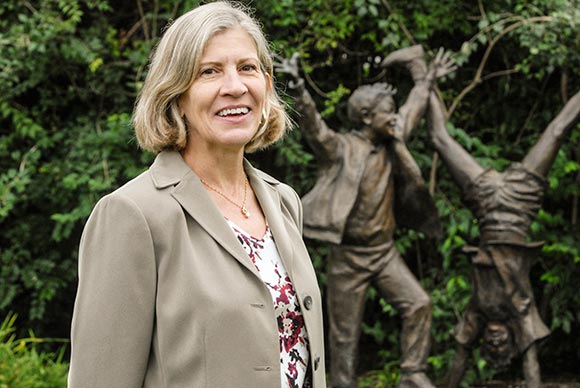It will be four years before Penn State University's football team can compete for the millions that come with playing in a NCAA college football bowl game.
Penn State, however, is remaining competitive in earning millions in government and private research contracts.
The numbers are so big, in fact, that they're worth digging into to determine just how much of an impact they can have.
“Let me explain,” says Patricia Gruber, deputy director of Penn State's Applied Research Laboratory (ARL). “Everyone figures the ARL got a check for $415 million. But not quite.”
Indeed, the Navy's Naval Sea Systems Command did award the ARL a contract in September worth $415 million for two million hours of research and development over five years, with an option to expand to $853 million and 3.9 million hours over 10 years. But that money and time represent a ceiling of possible work; they do not guarantee any actual work.
Gruber explains that the contract “simplifies the tasking problem for any government agency that wants to do work with us–to develop a prototype, et cetera. We still have go out and seek those research dollars.”
Even if the ARL does get all those dollars, the contract still represents a continuation of business as usual for the ARL and Penn State rather than an expansion, but with the fiscal cliff of possible defense cuts looming, continuity's not a bad thing for the university or its subcontractors in the Commonwealth.
Inside the Numbers
Located on Penn State's main campus in Centre County, the ARL is one of 14 University Affiliated Research Centers nationally that work mainly for the military, as well as NASA and the NSA. The ARL has been providing research and testing support to the Navy since 1945, and specializes in undersea propulsion and navigation, communications and acoustics, manufacturing, and related areas. It employs over 1,000 faculty and staff. In addition, it funds research for about 200 graduate students and 100 undergraduates annually, many of whom are then ideally poised for careers in the defense industry. Hence, keeping the ARL running is important to the local economy as well as Penn State's educational mission.
To put the ARL contract in context, Navy spokesman Chris Johnson says, “$415 million is definitely a sizeable contract, though the last contract we awarded for similar work had a ceiling price of $917 million.”
Johnson could not say how much of a typical contract is actually used, but noted criticisms that the contract was not competitively bid or open to industry were misguided.
“Federal law provides that full and open competition is not required when award is to be made to a particular source to 'establish or maintain an essential engineering, research or development capability to be provided by an educational or other non-profit institution.'”
Or as Gruber explains, “It's in the Navy's best interest to make sure ARL retains technical leadership in certain areas. It's a two-way street: we're committed to maintaining capabilities, and the Navy guarantees an indefinite delivery, indefinite quantity contract.”
Yet compared to the ARL's last five-year contract announced in 2006, which was capped at $444.8 million and 3.4 million hours, the current contract represents a slight reduction. Is Gruber worried Congressional budget cuts may reduce further the work that ultimately comes to ARL?
“Of course. That's my job. But basically we have to keep delivering and finding ways to make systems and products more valuable to the Navy and defense.” Nonetheless, she views the renewal of the contract as an affirmation by Navy and the Department of Defense that the ARL is valuable. In turn, “We're very proud to support our warfighters.”
Happy Valley and Beyond
The ARL's continued operation, meanwhile, has implications for the Commonwealth's economy beyond the university. Although the contract works out to $201 an hour, that money doesn't simply pay researchers and engineers at Penn State. The ARL does some basic research, but most of its work is applied research, which often entails building and field-testing prototypes. Hence, the ARL's contract dollars and hours must also cover subcontracts to other organizations and costs for equipment and material.
Funding thus flows from the ARL into the Keystone state, as Gruber explains: “We try as much as possible to work with Pennsylvania vendors. We're proud of that fact.” Hence, although jobs created by the ARL may not actually be in State College, they likely do remain in Pennsylvania because of procurement.
As important as the research funding is, it can't replace revenue from, say, missing football bowl games. First, notes Gruber, “With government awards, we have very specific terms and regulations for how we can spend money and what we can spend it on,” and rates are negotiated in advance with the Office of Naval Research. Second, the ARL doesn't generate much intellectual property for Penn State to license.
Gruber says, “We'll occasionally file license agreements, but that's not ARL's mission. We're not in the business of developing products and selling them back to the government.” Instead, the federal government has unlimited use rights to whatever the ARL produces. Basically, the government keeps what it paid for in the first place.
At the same time, the ARL is not Penn State's only recipient of Defense Department funding. For instance, the Army awarded the university a $34-million contract in September 2011 for night vision equipment and other optics. In August 2012, DARPA contracted with the university for $16 million of work on vehicle manufacturing. Nonetheless, the ARL is happy to continue to play its part and to be linked to the larger university community.
MARK MEIER is a writer, independent consultant, and part-time professor who lives in Dunmore and plants butterfly gardens in Scranton (which is his backyard). Send feedback here.
Photographs by BRAD BOWER



